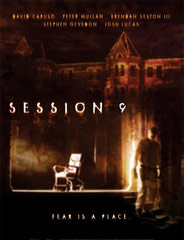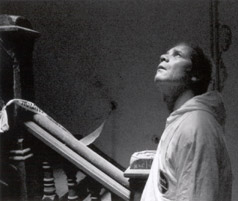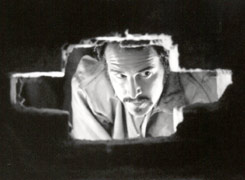| Session 9 |
| |
 |
USA, 2001. Rated R. 100 minutes.
Cast:
David Caruso, Peter Mullan, Josh Lucas, Stephen Gevedon, Brendan Sexton
III, Paul Guilfoyle
Writers: Brad Anderson & Stephen Gevedon
Music: Climax Golden Twins
Cinematographer: Uta Briesewitz
Producers: Dorothy Aufiero, David Collins, Michael Williams
Director: Brad Anderson
INTERVIEW:
DAVID CARUSO AND BRAD ANDERSON ON SESSION 9
LINKS
|
 uilt
in the 1870s and abandoned a century later, the red brick gothic estate sprawls
like a massive winged beast on a huge property in Massachusetts. This was no
playground for the privileged. This was a hospital, a dungeon for the insane,
where patients were forced into electroshock therapy, immersed in water, tied
into restraints, and given lobotomies, all in the name of "therapy." Designed
to house 2,700, as many as 7,000 souls were at one time crammed into its rooms
and subterranean passageways. Today, the floors sag, the asbestos-covered ceilings
and pipes leak, and the walls are defiled with graffiti. But virtually everything--the
hydrotherapy rooms, the solitary confinement cells, the morgue--is still intact.
Patient records still lie scattered in its storage rooms. This is no movie set,
no fictitious creation. This is the Danvers
State Hospital. This is what actor David Caruso calls the "scariest building
in North America."
uilt
in the 1870s and abandoned a century later, the red brick gothic estate sprawls
like a massive winged beast on a huge property in Massachusetts. This was no
playground for the privileged. This was a hospital, a dungeon for the insane,
where patients were forced into electroshock therapy, immersed in water, tied
into restraints, and given lobotomies, all in the name of "therapy." Designed
to house 2,700, as many as 7,000 souls were at one time crammed into its rooms
and subterranean passageways. Today, the floors sag, the asbestos-covered ceilings
and pipes leak, and the walls are defiled with graffiti. But virtually everything--the
hydrotherapy rooms, the solitary confinement cells, the morgue--is still intact.
Patient records still lie scattered in its storage rooms. This is no movie set,
no fictitious creation. This is the Danvers
State Hospital. This is what actor David Caruso calls the "scariest building
in North America."
Writer/director Brad Anderson (Next Stop,
Wonderland) and writer Stephen Gevedon could not have chosen a better
place to shoot their new horror movie, Session 9. Danvers has a presence
and authenticity that cannot be faked, and Anderson and Gevedon take full advantage,
having tailored their story to this specific location. Virtually everything
in the building, they say, is as they found it, and the tales related by the
characters about the place are largely true, with only names changed. Given
their limited budget, Anderson and cinematographer Uta Briesewitz rely as much
as possible on natural illumination, even indoors, having mapped out how light
strikes the building at various times of the day prior to beginning principal
photography. Be it by constraint or by design, their choice increases the naturalistic
feel, as does the decision to shoot the movie on digital video.
In this era of post-modern teen slasher films and computer graphics-saturated
genre pictures, Session 9 is an unusual film. It is a character study
foremost, and the building is the dominant character in the film--not in the
sense that there are morphing staircases and cherubs everywhere, like in The
Haunting, or over-the-top flashback sequences like The
House on Haunted Hill. Session 9 is far more subtle. As in The
Shining, a building can have a personality without it literally being so,
and the past can be present without it literally being so.
Session 9 focuses on the efforts of the ominously named Hazmat Elimination
Company to rid the enormous edifice of asbestos. The owner of the company is
Gordon (Peter Mullan from Trainspotting),
a Scottish immigrant with a newborn baby. The pressure of supporting a growing
family is beginning to get to him. Gordon's business is struggling, so he overbids
the project, promising the town engineer (Paul Guilfoyle) the seemingly impossible:
to get the three-week job done in just one, for which he and his crew will receive
a ten-thousand-dollar bonus.
Gordon's project supervisor is Phil (David Caruso), who wants to run things
like a military operation. In the beginning, Caruso is reminiscent of John Kelly,
his character on NYPD Blue, particularly when he says sensitive things
with a tough-guy attitude ("If you need anything, I'm here"), as only Caruso
can do (thank goodness he's getting movie offers again). Pretty soon he's showing
visible signs of strain himself and declaring that other members of the clean-up
crew are "liabilities."
Gordon and Phil bring in a crew of three men. Mike (Stephen Gevedon from HBO's
Oz) is a slumming law-school dropout. Uncertain of his direction in life,
he enjoys manual labor. There's none-too-bright Jeff (Brendan Sexton III, from
Boys Don't Cry), or "Mullethead,"
as Mike likes to call him because of his ugly haircut. He's basically a kid
happy to have work, but his inexperience may get in the way of completing the
project. Finally, there's Hank (Josh Lucas from American
Psycho), the Number One Liability in Phil's eyes. This may be due to
Hank's casual attitude toward his work, but more likely it has something to
do with the fact that he stole Phil's girlfriend and likes to brag about it.
As anyone who has spent a lifetime, a year, or even just a summer doing manual
labor will quickly recognize, these characters are authentically realized--they
give the impression of being real working-class people rather than actors pretending
to be. All of them would, of course, prefer to do something else, and one of
them talks of the necessity of having an "exit plan." As you might guess, having
an "exit plan" becomes a symbolic motif, and, of course, none of them has one.
The Danvers Hospital interacts with each character in a different way. It seems
to welcome one character in particular, and to another it offers a tantalizing
ticket out of his working-class existence. Yet another character is drawn irresistibly
to Danvers' mysteries, discovering a box marked "EVIDENCE" in a storage room.
In one of the "seclusion chambers," the characters discover newspaper cutouts
covering the walls, including messages like, "Suddenly it's going to dawn on
you," and "No one will leave feeling neutral." As the clean-up crew's mental
state deteriorates, the past comments on the present, coloring the atmosphere
and everything that transpires.
In addition to an impressionistic score that features Spartan single-note piano
passages, Anderson uses sound throughout Session 9 to unsettle the audience,
enhancing the sense that not all is as it should be. Intermittent droning and
whirring sounds are prominent, like the rush of cars driving by or windshield
wipers moving back and forth, never sounding quite right. Anderson's visual
style is understated--wisely so, given the extraordinary location--except for
the occasional use of rapid intercuts. For example, when the "EVIDENCE" box
is opened, an unsettling sequence of images flashes as the knife cuts through
the seal and the lid is opened.
Session 9 takes the time to work on the psychological level, taking
you into the darkest recesses of the characters' minds as it takes you into
the darkest recesses of the Danvers Hospital. That's true horror, because few
things are more terrifying than what the human mind can conjure up, or what
it's capable of under duress. As a result, even the stock genre devices Anderson
employs--the character who wears headphones when he shouldn't; the generator
running out of power at the wrong time--have their intended effect, because
they seem genuine in the context of the story. The conclusion is confusing,
but most of the pieces do fall into place upon reflection. It is unfortunately
common in horror for the climax and resolution to fail to live up to expectations
created by the buildup in tension, but Session 9 cashes in satisfactorily.
Session 9 is one the most horrifying movies you will see this year,
and it's not even technically a horror film--at least, not as many people understand
horror to be. In other words, there are no mask-wearing psychos or ghosts that
jump out and yell "Boo!" Anderson and Gevedon's script doesn't rule out a supernatural
dimension to the story, but it is not necessarily present. Everything in the
movie has a plausible explanation. Whether something otherworldly is happening
is left to the audience to decide, and that's part of the fun.
CONTINUE
TO THE INTERVIEW: DAVID CARUSO AND BRAD ANDERSON ON SESSION 9
Review
© August 2001 by AboutFilm.Com and the author.
Images © 2001 USA Films. All Rights Reserved.



